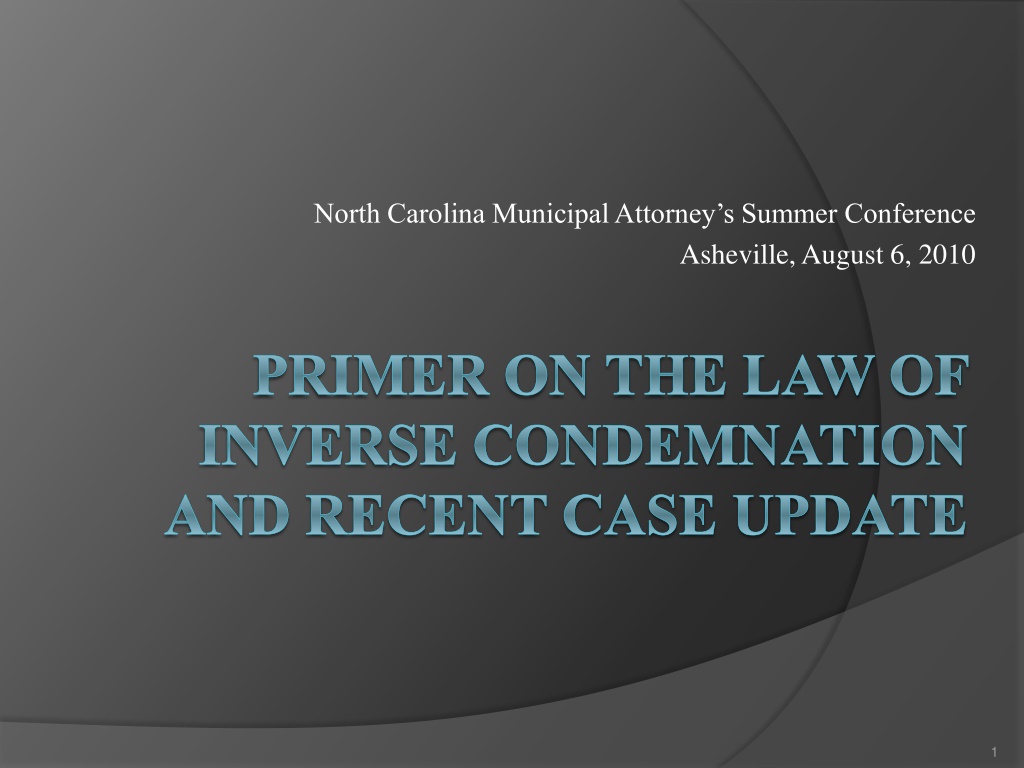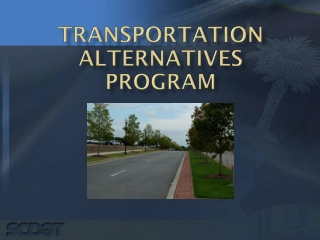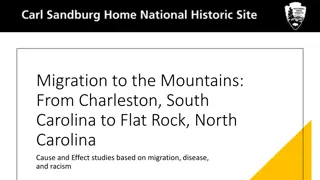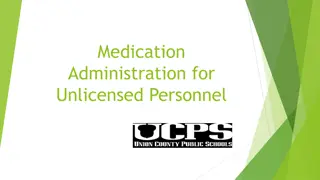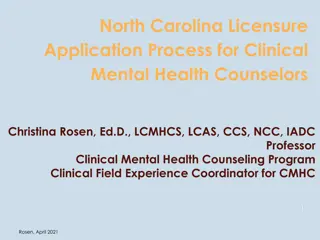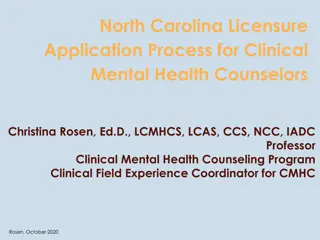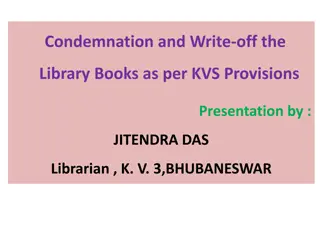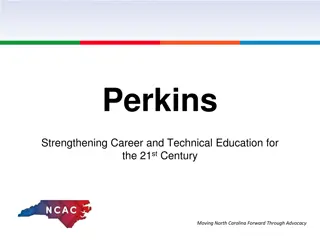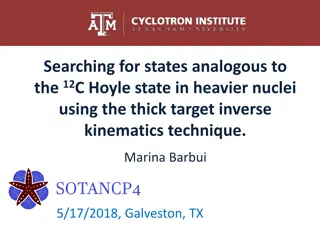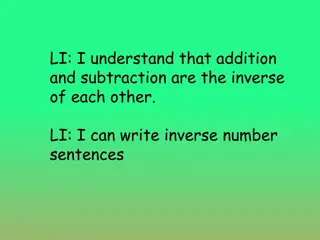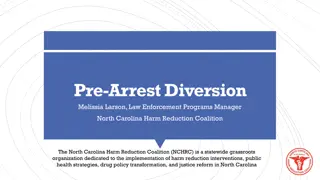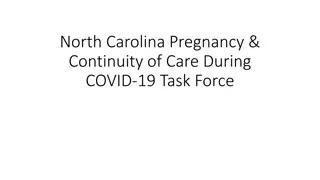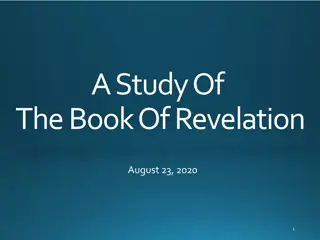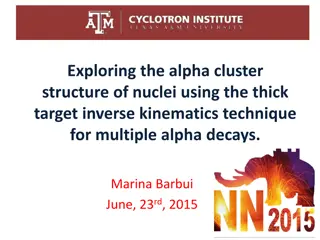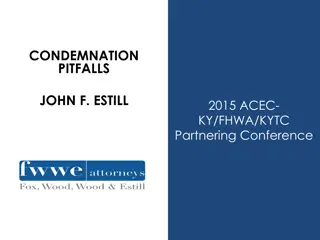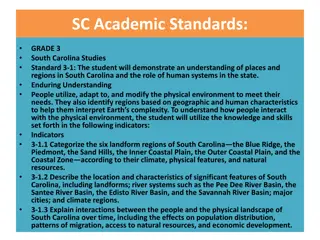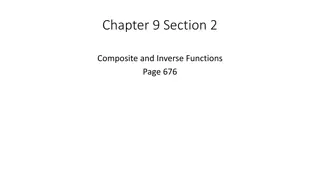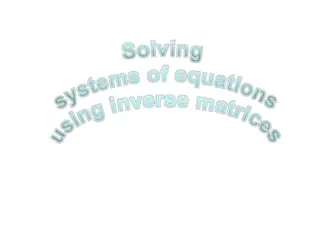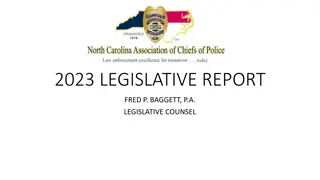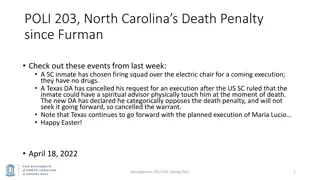Understanding Inverse Condemnation Law in North Carolina
Explore the nuances of inverse condemnation law, including its history, basis in fundamental constitutional rights, N.C. statutory framework, attorney fees, and major categories of inverse takings. Learn about the actions, burdens of proof, and legal principles involved in these cases.
Download Presentation

Please find below an Image/Link to download the presentation.
The content on the website is provided AS IS for your information and personal use only. It may not be sold, licensed, or shared on other websites without obtaining consent from the author. Download presentation by click this link. If you encounter any issues during the download, it is possible that the publisher has removed the file from their server.
E N D
Presentation Transcript
North Carolina Municipal Attorneys Summer Conference Asheville, August 6, 2010 PRIMER ON THE LAW OF INVERSE CONDEMNATION AND RECENT CASE UPDATE 1
Inverse Condemnation History and Nature of Action A taking without formal exercise of eminent domain Charlotte v. Spratt Device to force government to exercise e.d. Smith vs. Charlotte Taking = actual interference or disturbance of property rights resulting in injuries not merely consequential or incidental. Adams Damage must grow out of the ownership of property and be substantial enough to reduce market value. Long v. Charlotte 2
Action lies only against entity with E.D. powers Galloway Inverse Condemnation action requires injury to property of an essentially permanent nature. Burden of proof is on the land owner. Penn Central Intent to condemn is of no consequence. In Re: Sioux Tribe 3
Fundamental Constitutional Rights Basis of Action From the U.S. Constitution, Fifth Amendment nor shall private property be taken for public use without just compensation. There is no Takings Clause in N.C. Constitution. N.C. Constitution Article 1, Section 19 Law of the Land Clause guarantees no taking without compensation 4
N.C. Statutory Framework Inverse Condemnation against Local Government Actions against local government condemnors G.S. 40A 51: Remedy where no declaration of taking filed See Article 3, Chapter 40A, GS40A 40 through 40A 70. Actions against the State, usually NCDOT, but a few cities GS 136-111: Remedy where no declaration of taking filed See Article 9, Chapter 136, G.S. 136 103 through 136 121.1 5
Attorneys Fees Noattorneys fees in regular condemnation actions. McNeely Attorney s fees available to successful inverse claimants. (Hidden in) G.S. 40A-8 and G.S. 136-119 Costs and Appeal 6
Major Categories of Inverse Taking There is a wide variety of government actions that may support claim in inverse. Workable rules are elusive. Szypszak: 1) Interweaving and distortion of property and tort law concepts 2) Artificial interpretation of eminent domain provisions 3) Untidy compilations of legal theory It is useful to break down inverse claims into three main categories: 7
Three Categories 1. Direct Physical Appropriation/Expropriation ( Normal government activity without proper paperwork) 2. Physical Intrusion/Interference (Noise, smoke, odor, flooding) 3. Non-physical, Regulatory Takings (Confiscatory zoning, permit denial precluding economic use, development moratoria, unreasonable exactions, regulations going too far ) 8
1. Direct Expropriation De Facto Condemnation Actual physical entry always a taking. Terminal Warehouse Corp. Denial of all access a compensable taking. Preliminary, temporary entries for surveys etc. not a taking. Herndon; G.S. 40A-11, 136-111. Excess taking arising in conventional action (inverse by counterclaim). Bragg Damage to remainder inverse taking. Hollingsworth, Pearce 9
2. Physical Intrusion/Interference (Flooding, noise, smoke, odor, etc.) Delineating the boundary between normal annoyances and compensable deprivations. Flooding analogizes best to appropriation of property. Lea Co., Warehouse Corp. Nuisance like activities may be found to constitute inverse taking. Edwards v. Raleigh Permanent servitude having discernable effect on market value vs. single, tortious act. Bynum 10
3. Regulatory Takings (Non-physical appropriation by government action) Takings traditionally required physical occupation. Ultimately S. Ct. recognized that regulation can effect a taking. San Diego Gas and Electric Early Taking cases focused on regulating nuisance-like activities. (No property right in noxious activity). Parker More recently going too far analysis. 11
3. Regulatory Takings U.S. Supreme Court decisions: Pennsylvania Coal (1922) regulations may go too far. Penn Central (1978) balancing, ends-means test. First English Evangelical Lutheran (1987) prohibition against all development in flood area a taking. Lucas v. S.C. Coastal Comm. (1992) the categorical rule. City of Monterey v. Del Monte Dunes (1999) Sierra-Tahoe Preservation Council (2002) a development moratorium is not a taking under facts of the case. 12
N.C. Regulatory Takings Cases Schmidt v. Fayetteville (1983) Property value loss insufficient. Helms v. Charlotte (1961) Zoning is confiscatory and a taking if all economic uses of property are prohibited. Finch v. Durham (1989) Zoning regulations dramatically reducing value of property upheld. Responsible Citizens v. Asheville (1983) Floodplain zoning not a taking. 13
Exactions and Dedications U.S. Supreme Court, in Nolan and Dolan, required rational nexus and rough proportionality between exaction and development impact. 14
N.C. Exactions Cases Riverbirch Assoc. v. Raleigh (1990) requirement to dedicate open space/parkland as a condition of development approval upheld. Batch v. Chapel Hill (1989) parkway dedication requirement as condition of subdivision approval not sufficiently proportional to impact/service burden of the development. 15
Exclusivity of Inverse Remedy Trespass and nuisance superseded by G.S. 40A- 51. McAdoo Negligence claims preserved. Howell v. Lumberton Action to invalidate regulation still viable. Frank, A-S-P Assoc. v. Raleigh Sec. 1983 action for constitutional infringement under color of state law. Rodgers, 4th Cir. Land use disputes still local. 16
Statute of Limitations G.S. 40A-51 (136-111) requires action within later of 24 months of taking, or project completion. Project may be segmented. McAdoo Regulatory takings statute runs upon adoption/effective date. Two-year stat. period tantamount to title. Smith Law of prescriptive easements irrelevant. (Lawrence) Courts sympathetic to landowner claims in light of two-year bar. Hoyle 17
CASE LAW UPDATE RECENT NC COURT DECISIONS ON INVERSE CONDEMNATION 18
(Flood and Stormwater Cases) Howell v. Lumberton 144 N.C. App. 695 (2001) Negligence claimed in storm drain maintenance 40 A-51 Inverse not preemptive of negligence action. Most recent damage was within three year statute. Permit issuance = licensee duty owned. 19
Tate v. NCDOT 176 N.C. App. 530 (2006) Undersized drain in highway flooded P s house during Hurricane Floyd. Dismissal of inverse action did not preclude IC action in negligence, and no res judicata. G.S. 40 A-51 did not preclude IC action. 20
Lakeview Condo Assoc. v. Pinehurst (2007) Silt passing through street culvert filled P s pond. Dismissal of nuisance and trespass action, negligence action remained. Not necessary for town to cause the silt or own the drainage way. Reasonable use doctrine no defense. Town has duty to take reasonable measures to reduce silt passing through its street culvert. 21
Asheville Sports Properties v. Asheville 683 S.E.2d 217 (2009) Negligence claim for sinkhole damage. Private drainage line on private property collapsed. Interconnections with City drainage system above and below not sufficient to find adoption. 22
First Gaston Bank of N.C. v. Hickory ___ N.C. App. ___ (2010) Private drainage line collapsed, destroying structure inverse and negligence claimed. City controlled upstream and downstream connection points. City issued repair permits to fix line. City s approval of upstream developments, resulting in increased drainage flows no basis for negligence. No duty to analyze and design drainage systems for anticipated private development. 23
(Statute of Limitation Related Cases) Stahr v. NCDOT (NCCOA 2010) (Unpublished) Road improvements caused severe erosion on p s property. Repairs attempted; State gave up on repairs. Insufficient findings of fact that statute had run. Statute construed to favor landowners property rights claims. 24
De Hart v. NCDOT 195 N.C. App. 417 (2009) Inverse action for too steep driveway contrary to consent judgment stipulation. No inverse taking as no actual, permanent invasion for public use. Sole remedy in contract breach, and barred by statute of limitations. 25
Peach v. High Point __N.C. App.__ (2009) Failure to connect new sewer main to residence caused sewage backup and total loss of use/value. Inverse action allowed in addition to negligence action. Generalized, not repairable, permanent damages = market value diminution. G.S. 40A-51: Statute of Limitations construed to favor landowner (date of contractor s return to repair omission). 26
Town of Red Springs v. Williams 163 N.C. App. 358 (2004) Town built sewer line on D s property without easement. Exclusive remedy of owner was in inverse. Statute had run owner had a ten-year opportunity to file action. Two years = good title 27
(Odds and Ends Cases) City of Charlotte v. Long 175 N.C. App. 750 (2006) Post-judgment septic field mitigation, with owner s consent, not an inverse taking. No public appropriation. Did not necessarily flow from the project. 28
6214 S. Blvd. Holdings LLC v. Charlotte (NCCOA 2006, Unpublished) Mere planning and plotting for light rail project, even if impairs ability to lease property, not an inverse taking. 29
Charlotte v. BMJ of Charlotte ___ N.C. ___ (COA 2009) Railroad easement quitclaimed by N&SRR to Charlotte for light rail use P claimed inverse from diminished access to property. Non-use by railroad no abandonment. Use and conversion to light rail not an overburdening. 30
Frances Austin Ptnshp. v. High Point 177 N.C. App. 753 (2006) Leaving old sewer pipe in ground after abandonment not a taking. Abandonment may be unilateral and without consequence. City not required to pay twice for the easement. 31
Al-Nasara v. Cleveland County (N.C. App. 2010) (Unpublished) P sued county in inverse for demolishing cited building without proper statutory notice. While building code enforcement is a governmental function, and purchased insurance excluded inverse coverage, sovereign immunity is inapplicable to inverse condemnation claims. 32
Wilfong v. NCDOT 194 N.C. App. 816 (2009) Another DOT too steep driveway case, following R/W settlement. Interlocutory order finding P was entitled to compensation at G.S. 136-108 preliminary issues hearing. Not immediately appealable without showing substantial right was at stake. 33
T-Wol Acquisition Co. v. Durham Housing Authority (NCCOA 2006, Unpublished) P sued housing authority in trespass and inverse over disputed title. Inverse condemnation was the sole remedy. Requirement for certificate of convenience and necessity procedural matter only and no defense to authority s having e.d. power. 34
Natl. RR Museum and Hall of Fame v. Hamlet (NCCOA #08-356, Unpublished 2009) P sued town over demolition of headquarters building; anticipated leasing rehabilitated depot; lease not consummated. Remedy of breach of contract and fraud dismissed. No inverse taking, as plaintiff had not complied with G.S. 40A-51 by failure to file and record memo of action. 35
Cary Creek Ltd. Ptnshp. v. Cary (N.C. App. 2010) Dec. action challenging stream buffer rules and, alternatively, action in inverse. So long as appeal from variance denial and declaratory judgment are not finally determined, no inverse condemnation action possible. No subject matter jurisdiction inverse dismissed. 36
